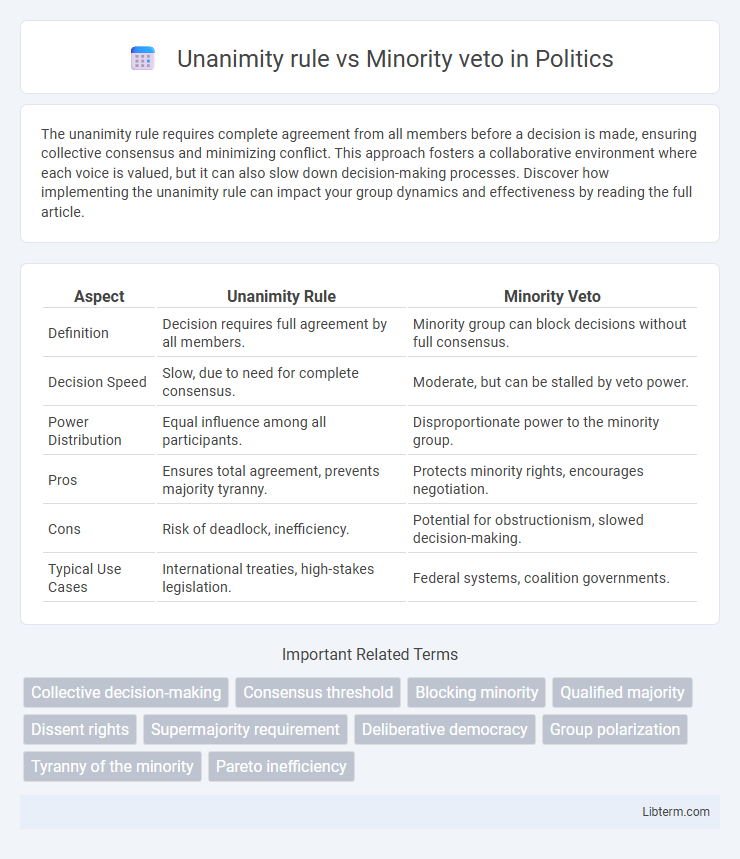The unanimity rule requires complete agreement from all members before a decision is made, ensuring collective consensus and minimizing conflict. This approach fosters a collaborative environment where each voice is valued, but it can also slow down decision-making processes. Discover how implementing the unanimity rule can impact your group dynamics and effectiveness by reading the full article.
Table of Comparison
| Aspect | Unanimity Rule | Minority Veto |
|---|---|---|
| Definition | Decision requires full agreement by all members. | Minority group can block decisions without full consensus. |
| Decision Speed | Slow, due to need for complete consensus. | Moderate, but can be stalled by veto power. |
| Power Distribution | Equal influence among all participants. | Disproportionate power to the minority group. |
| Pros | Ensures total agreement, prevents majority tyranny. | Protects minority rights, encourages negotiation. |
| Cons | Risk of deadlock, inefficiency. | Potential for obstructionism, slowed decision-making. |
| Typical Use Cases | International treaties, high-stakes legislation. | Federal systems, coalition governments. |
Overview of Decision-Making Rules
The unanimity rule requires complete agreement from all group members to pass a decision, ensuring full consensus but often resulting in slower processes and potential deadlock. In contrast, the minority veto allows a smaller subset of members to block decisions, protecting minority interests but potentially limiting majority efficiency. Both rules balance inclusivity and effectiveness differently, influencing group dynamics and decision outcomes significantly.
Defining the Unanimity Rule
The unanimity rule requires that all members of a decision-making body agree to approve a proposal, ensuring complete consensus before action is taken. This rule promotes inclusive participation and guarantees that no minority is overridden or marginalized, enhancing collective legitimacy. Unlike the minority veto, which allows a small group to block decisions, unanimity mandates universal agreement, making decision-making processes more stringent and equitable.
Understanding Minority Veto Power
Minority veto power grants a small subgroup the ability to block proposals, preventing decisions that may harm their interests. In contrast to the unanimity rule, where all members must agree, minority veto enables protection of minority rights without requiring full consensus. This mechanism balances decision-making efficiency with safeguarding against majority dominance.
Historical Context and Development
The unanimity rule emerged in early democratic assemblies, emphasizing complete agreement to legitimize decisions and prevent tyranny of the majority. Minority veto power developed as a counterbalance to protect minority interests from potential oppression in majority-rule systems, notably influencing intergovernmental organizations and constitutional frameworks in the 20th century. Both mechanisms reflect evolving efforts to balance collective decision-making with protection of minority rights throughout political history.
Key Advantages of the Unanimity Rule
The unanimity rule ensures that all parties agree before a decision is made, fostering full consensus and maximizing group cohesion. This rule prevents the dominance of majority interests, protecting minority rights and encouraging more inclusive, carefully considered outcomes. It also reduces the risk of conflict and promotes long-term cooperation by requiring collective commitment.
Strengths of Minority Veto Mechanisms
Minority veto mechanisms strengthen decision-making by protecting the interests of smaller groups against potentially oppressive majority rules, ensuring more balanced and inclusive outcomes. These mechanisms prevent hasty or unfair decisions by requiring broader consensus, fostering greater collaboration and deliberation. Minority vetoes enhance stability in governance by reducing conflicts and promoting compromise among diverse stakeholders.
Unanimity Rule: Challenges and Criticisms
The unanimity rule requires full agreement among all members, often leading to decision-making gridlock and inefficiency, especially in large groups. Critics highlight the paralyzing effect of a single dissenting member, which can obstruct progress despite widespread consensus. This rule also raises concerns about the potential for strategic blocking and disproportionate influence by minorities.
Minority Veto: Potential Risks and Limitations
The minority veto grants a small group the power to block decisions, potentially causing deadlock in organizational or legislative processes. This mechanism may empower obstructionism, slowing decision-making and reducing efficiency by enabling a few to override the majority will. Risks include increased negotiation costs, diminished collaborative outcomes, and potential manipulation by minority factions to stall or derail important initiatives.
Comparative Analysis: When to Use Each Rule
Unanimity rule ensures collective agreement, making it ideal for decisions requiring full consensus and minimizing conflict in small groups or high-stakes situations. Minority veto empowers a subgroup to block decisions, providing protection for minority interests in diverse or polarized settings common in legislative bodies or corporate boards. Choosing between these rules depends on the need for inclusivity versus protection of dissenting voices, balancing efficiency and fairness in decision-making processes.
Implications for Governance and Consensus-Building
The unanimity rule in governance requires all participants to agree before a decision is finalized, which fosters inclusive consensus-building but can lead to gridlock and slow policy implementation. In contrast, the minority veto grants a smaller faction the power to block decisions, protecting minority interests but potentially empowering obstructionism and reducing efficiency. Balancing these mechanisms is crucial for creating governance structures that promote both democratic representation and effective decision-making.
Unanimity rule Infographic

 libterm.com
libterm.com